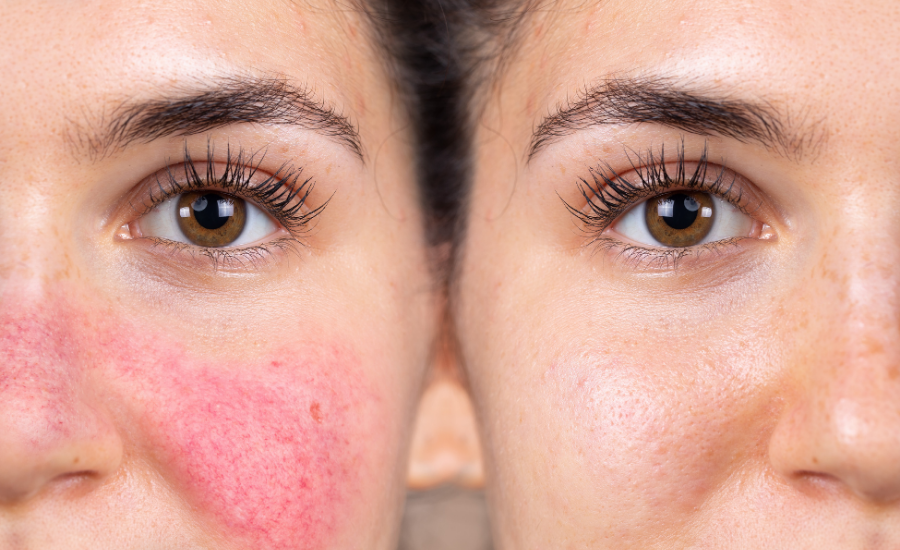April is rosacea awareness month, and though rosacea is a common skin disorder, there remain many misconceptions that can be discouraging and demoralizing for those impacted by it. The sideways glances, stares, or the assumption from some that the visible signs of rosacea are related to alcohol use or the belief that it’s contagious can be emotional for those living with it.
Here are some important facts about rosacea, for those who have it, those who have loved ones impacted by it, and those seeking to learn more.
What is rosacea?
Rosacea is a common, chronic, inflammatory skin disorder, primarily affecting the face of adults with fair skin. Often presenting as a chronic red rash, rosacea can recur intermittently for years.
Who is most likely to have rosacea?
More common among women, rosacea impacts an estimated 22% of fair-skinned women of Celtic origin. It often appears during the 30s and 40s, though it may also affect children and teenagers.
What are the signs of rosacea?
Rosacea has a range of symptoms, often starting with intermittent flushing of the face. It may progress to persistent redness and the appearance of many small, prominent and broken blood vessels. Small red bumps and pimple-type lesions can occur, mainly on the nose, forehead, cheeks and chin, and the skin may also become dry and flaky. In extreme cases, there may be an unshapely, red, thickening of the nose – like that of W.C. Fields. It can also affect the eyes, causing redness and eye irritation.
What causes rosacea?
The cause of rosacea is unclear, but is thought to be a combination of factors including genetic, environmental, vascular and inflammatory. It may be a disorder of the immune system and our body’s regulatory response to temperature, resulting in inflammation and altered blood flow, with structural changes to the skin and blood vessels. Chronic exposure to the sun may play a role as well. There has been some association between rosacea and hair follicle mites, though this is not thought to be causation.
Is there a cure for rosacea?
No, there is no cure but it can be managed. There are lifestyle elements that can help reduce the symptoms, and treatment options to assist during a flare-up and when it is rosacea is stabilized. The newer treatment options available are giving new hope to those that live with this chronic condition.
What can I do to control my rosacea?
Many have discovered it can be exacerbated by the consumption of spicy food, hot drinks, and alcohol – especially red wine. It’s also important to protect the skin from the sun, so a daily sunscreen is essential. Limiting exposure to extremes of temperature and irritating skin care products may also help. Avoiding these triggers can help reduce the risk of a flare-up.
What treatment options are available for rosacea?
There are several ways to treat rosacea: specialized skin care products, topical prescription creams and gels, oral antibiotics, and light therapy.
For both topical and oral treatments, it can take six to eight weeks of treatment before any response is noticeable, so it’s important to be patient and persist with the treatment program.
Specialized skin care products
Choosing skin care products and lotions designed for rosacea skin can help. Most important is to avoid the use of any skin care products that are scented or have stimulating ingredients. At INLIV, we offer the following specialized products:
- Vivier products specially formulated to reduce redness
- Jane Iredale Mineral Make Up to help disguise redness. It’s non-comedogenic, mineral-based and fragrance-free to promote healthy skin
Topical prescription creams and gels
Topical antibiotics such as metronidazole can be helpful. To temporarily reduce persistent symptoms of redness, the topical gel, brimonidine, can be used intermittently. This is a good option for those seeking to quickly diminish redness when planning to attend a special occasion or event.
Ivermectin cream is used to target hair follicle mites and reduce inflammation and other topical agents such as Azelaic acid may also help.
Unlike many red skin rashes, the use of cortisone cream is not advised for rosacea. Though it may provide temporary relief, it will make the symptoms more severe with a rebound phenomena.
Oral antibiotics
Oral antibiotics are often used in tandem with topical treatments. Tetracycline-based antibiotics are particularly helpful due to their anti-inflammatory effect. A low dose of doxycycline can act as an anti-inflammatory with minimal anti-microbial effect, to reduce the risk of side effects and antibiotic resistance that can occur with prolonged use of oral antibiotics.
Light therapies
Even when rosacea is under control or stabilized, the dilated and broken blood vessels of the skin can remain. Treatments such as intense pulsed light and laser therapy can be administered to reduce or eliminate these persistent vessels. These procedures use light energy to create heat that seals the vessels and reduces any residual redness.
INLIV provides Intense Pulsed Light to help reduce the appearance of broken blood vessels and redness. Our medical aesthetic physicians may also prescribe prescription creams, gels or antibiotics, if needed.
For those people living with rosacea, it can be frustrating, painful, and can take an emotional toll, as well. If you’re struggling with rosacea, contact our INLIV medical aesthetic professionals for a personalized consultation to review the options best suited to you.
Want answers on what treatments and products are best for you?
- Book a skincare consultation by email or by phone – 403.538.8881. Nadia Zinchuk, our INLIV Medical Aesthetics registered nurse offers personalized skin care analysis. Following your assessment, Nadia will provide you with recommended products for at-home care in addition to treatment options.
- Click here to read more about our medical aesthetic treatments. You can now search by the condition you’re experiencing or by the treatment you’re interested in.


